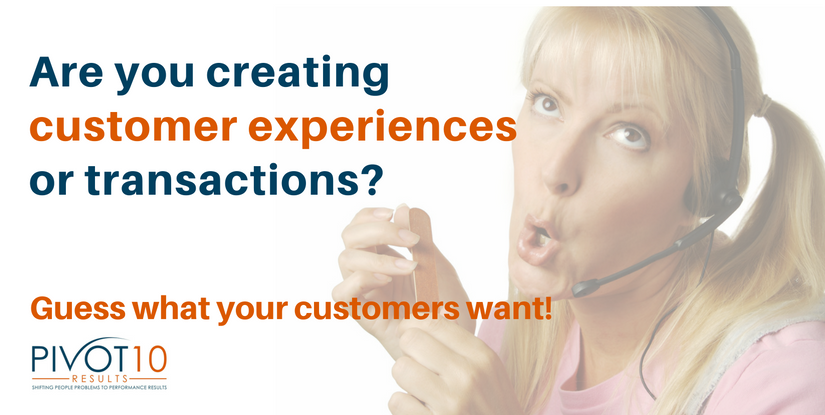This is Part 3 in my series of “What I Learned at Zappos Culture Camp”
By Gina Trimarco
What does it mean to “create an experience” for customers (and employees) beyond a “transaction” (exchange of money for a service or product)? A recent transaction I had was on my least favorite airlines, Spirit, in which they cancelled my flight with no more flights for two days. Horrible experience and their best offer was a refund. Flying Spirit is always a transaction and never an “experience”, not a good one at least.
FANtastic Customer Experiences™ have become selling tools for repeat business and free word-of-mouth marketing. Millennials, for example, are the fastest growing travel segment and they will choose a hotel or lodging in proximity to “experiences” they can have. They will choose experiences over amenities in many cases. Humorous Delta flight attendants create experiences in their safety announcements to make travel more tolerable (and sometimes enjoyable). A client who sent me flowers when I was in the hospital created an experience of feeling appreciated as a vendor. A doctor who said to my mother “How can I make things better for you today?” created such a memory that she won’t stop talking about it.
Creating FANtastic Customer Experiences™ creates raving fans and increased revenue because customers will talk about the two extremes in service – awful and amazing. Keep in mind that this should be a core value and/or mission of a company versus doing it just for the money. Some companies, like Spirit Airlines, take pride in not having this as a core value and are pretty transparent about their “no frills” approach. It’s just sad that many companies consider it a frill to give good service.
Zappos.com lives and breathes for creating customer relationships and connections. Their mission is to provide the best customer service experience. Their employees make decisions based on the company mission and core values.
If you take anything away from this post, embrace the concept of Personal Emotional Connections (P.E.C.), that lead to creating experiences. Creating P.E.C.’s, a Zappos customer service tool, is a pretty simple concept and one that seems to be overlooked, especially in phone transactions, whether in customer service or sales.
Recently one of my colleagues asked me to “role play” with some potential job candidates for a sales position for one of her clients. I was amazed and disappointed by the lack of rapport building in their “interviews” with me. One even said, “This is a cold call.” Granted, they were nervous and they weren’t on real sales calls in their minds … but yet they WERE on real sales calls because they were trying to get me to buy into recommending them for the job. And the whole time they were treating me like a transaction to process. They had a target to hit and forgot to connect with me. This is extremely common in the medical industry too. Doctors and nurses in a hospital focus so much time on carrying out their jobs that they forget their customers are human beings.
The majority of sales people who call me NEVER try to create a connection through finding commonality. I mean NEVER. They go straight for the transaction. This is especially important on a cold call. If you’re talking to a customer for the first time, PLEASE take the time to make some “small talk”. So, if you are the rare sales person who says, “How’s your day going today?”, I will most likely make time to talk to you! People like and trust people who are like them. This is truly such a simple and easy practice that is taken for granted and can be taught to employees. Zappos teaches it and teaches it well. They call it creating a “WOW” experience.
How Zappos “WOWs” Their Customers:
1) What the customers see first – since they are an online business, they make sure that prominent information is clear and easy to find on their website, including their phone number and key selling points such as free shipping, free return shipping and their 365-day return policy. So many companies purposely make it impossible for customers to call them and instead send customers into voice and online chat system vortexes of doom. Think about the many websites that bury their phone numbers!!!
Meanwhile Zappos thrives on talking to their customers. They actually try to find ways to drive calls because it gives them an opportunity to connect and create relationships that lead to referrals and repeat sales. They overstaff on purpose to make sure there are enough employees available with no wait times. Instead of spending money on marketing they spend money on creating experiences through customer service touch points. Only 3% of their customers call in and they leverage this by creating connections.
This is why there are no call time quotas – the telephone is one of the best branding devices available, so they encourage their employees to stay on the phone with customers as long as necessary. Employees even have been known to become Facebook friends with customers because of the connections they create.
And there are no sales-based performance goals for these employees because the service they provide produces repeat revenue.
2) What the customers experience – Simple practices go a long way. Zappos likes to surprise their customers by over delivering, being friendly and helpful and going “above and beyond”. If they don’t have something the customer wants they assist them with finding the product elsewhere.
I just lived through Hurricane Matthew. In preparation for evacuation I spent two hours trying to find a hotel out of our area to flee to. Each time I asked “Any idea who might have rooms?” Imagine how I would perceive these hotels if they could have made a single recommendation in my emotional time of need!
As I mentioned in Part 1 in this series, Zappos hasn’t recreated the wheel. They study successful businesses, continuously educate themselves and employee common sense. They embrace an old school way of doing whatever it takes to make customers happy similar to the Nordstrom’s approach.
Nordstrom’s doesn’t have return policy, meaning there is no time limit or reason for return needed to return an item. Nordstrom customers can take beaten up, dog-eaten pairs of 10-year-old jeans purchased from them and get a refund or exchange. Visit the Nordstrom website and you’ll find:
“We handle returns on a case-by-case basis with the ultimate objective of satisfying the customer. We stand behind our goods and services and want customers to be satisfied with them. We’ll always do our best to take care of customers—our philosophy is to deal with them fairly and reasonably; we hope they will be fair and reasonable with us as well.”
The 600+ “Customer Facers” at Zappos, also known as Customer Loyalty Team Employees deliver experience by:
- Answering 5,000 – 6,000 calls per day
- Responding to 100% of emails in the first hour received
- Answering 80% of calls in 20 seconds or less
- Communicating with customers on Twitter at their own twitter handle @Zappos_Service
The return on investment for creating what Pivot10 Results calls a “FANtastic Customer Experience™” is:
- 75% of their customers become repeat customers
- Those repeat customers purchase 2.5 times per year
- Repeat customers have higher average orders than 1st time customers
To enhance the customer experience, the Zappos call center in Las Vegas (not another country) is open 24/7. They close only for quarterly “All Hands” meetings for a few hours and occasionally for staff teambuilding (my favorite phrase) outings.
What Makes Zappos So Good At Customer Service?
Zappos employees go through an initial five weeks of immersive training that includes department presentations, core values, empowerment, practice time, role playing, feedback and a test they must pass to stay employed. And upon passing the test they’re given “The Offer” – an opportunity to get paid for quitting if they don’t feel like Zappos is the best fit for them. Only 1% of new employees take this offer. This practice ensures having people who really want to do their jobs.
To further assist employees with giving the best customer service, employees have a variety of support tools available to them including:
- Resource Desk – help desk to answer questions if they have doubts
- Customer Loyalty Team (CLT) Academy – for additional training
- CLT Liaison
- Operations – staffing, forecasting, analytics
- Order Verification Team (handles fraud)
- Engagement & Appreciation – this department (“circle” per Holocracy) creates teambuilding events and socials to keep employees engaged and feeling appreciated
What Does This Mean For Your Company?
Whether you provide a product or service, no one likes to be “processed” or feel like a number. When you create positive experiences for your customers you make them feel appreciated immediately. Even if your company is the only company that can provide a certain product or service (at this moment), like a utility company, it still pays to create experiences that make your customers brag. You never know when competition will show up to lure your customers while you’re being complacent and cocky. Customers will leave you in a heartbeat because they just don’t like you if they have another option.
Teach your employees to pivot with experiences, not transactions.
Need help with this? We’ve got your back and you can bet we’ll create an experience for your entire organization.
Contact me directly at gina@pivot10results.com for more information about training your employees to create FANtastic Customer Experiences™ that result in repeat sales and free word-of-mouth marketing.
If you’re feeling stuck, it’s time to pivot!
-Gina
P.S. Part 4 of this series coming next week is “Recruit, Train, Retain – Attracting & Keeping Top Talent”
ABOUT THE POST AUTHOR
Gina Trimarco, Chief Results Officer, knows how to pivot to profits from problems and find joy through the process. Her philosophy is that performance pays and people need to be trained to perform on the stage of business to achieve results.
pivot to profits from problems and find joy through the process. Her philosophy is that performance pays and people need to be trained to perform on the stage of business to achieve results.
Gina successfully pivoted from her entertainment company Carolina Improv Company to spinning off Pivot10 Results, a strategic training and consulting firm that helps business teams to quickly adapt their communications and engagement skills in leadership, customer and sales to achieve results by providing them experiential learning tools and strategies.




